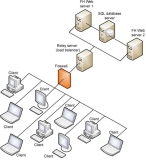The servers and the client computer relationship
You will need at least three separate computers for a basic installation of FH Web.
- A FH Web server, which runs the installation of FH Web, FH Web Connection Manager, and web services,
- A SQL server that maintains the FH Web data in a SQL database and communicates with the FH Web server.
- One or more client workstations, which communicate with the FH Web server. A client workstation only needs an Internet web browser to access and run FH Web.
The FH Web Connection Manager controls client access to the FH Web server.
Tip: For better performance, SQL Server should run on a different computer than the FH Web Server.
Users on client computers view the normal FH interface through a web browser, and their computers send and receive FH data on the SQL server through the FH Web server.
The servers should be fast computers that can be assigned a unique address. The SQL database server should not be a computer that is also used as a file server. Ideally, it should be dedicated to hosting the database engine and the FH database. If necessary, the server can also host other SQL databases.
If you need to add additional FH Web servers to support the number of client computers accessing the FH data, you also need to add an additional server to act as a relay server/load balancer. This relay server accepts incoming client connections and directs them to the FH Web server that currently has the lightest processing load.
Warning: Do not cache in the FH Web configuration.
More information on load balancing an FH Web installation is available in the FH Web Administrator's Guide.

